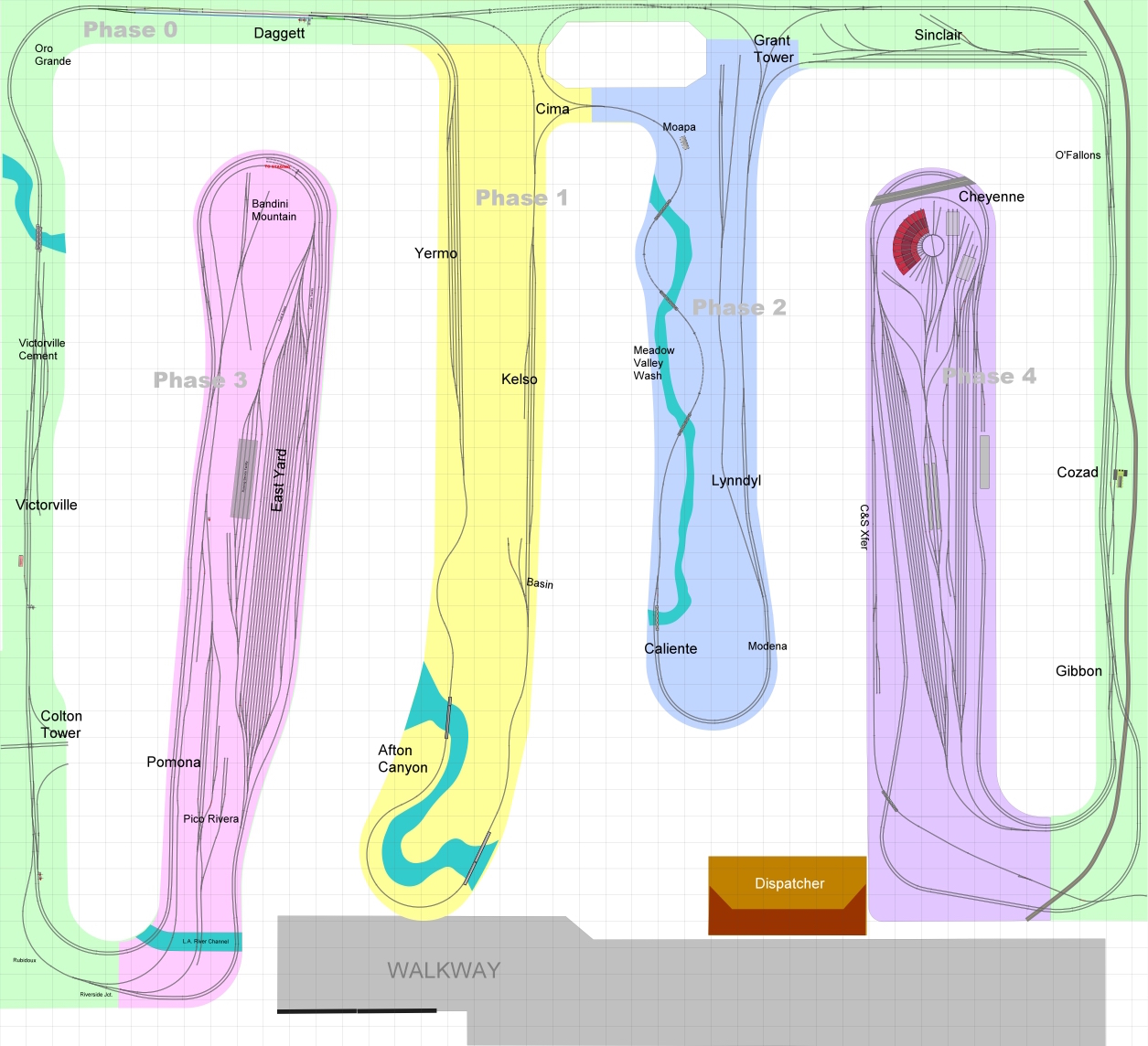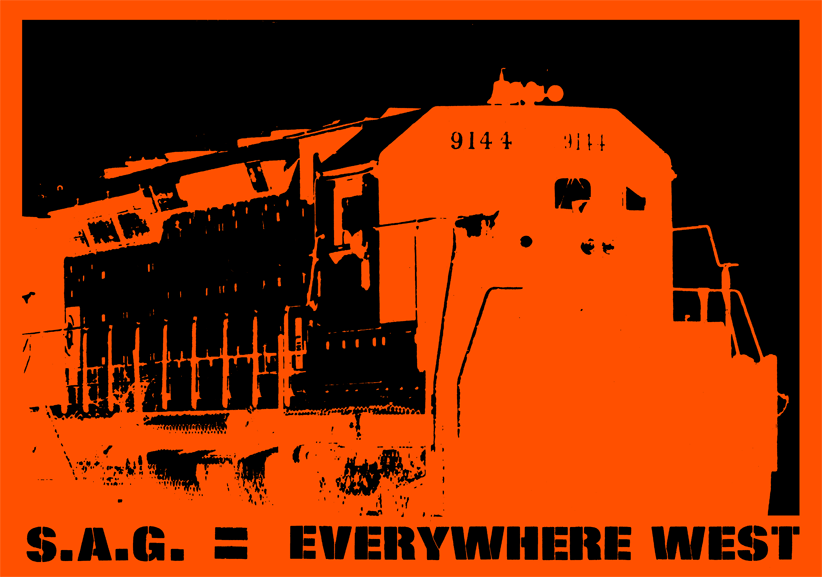
Updated 1/12/2020
The Gibbon, Cozad and Western
is an N scale model railroad under construction in Centralia,
Illinois. Started in 2012, the GC&W was undertaken as a
retirement project by a long-time model railroader to realize a
lifelong dream to build and operate a large model railroad. The
layout's depictions are vignettes of the pre-1982 Union Pacific
mainline between Los Angeles and central Nebraska. Special
emphasis is on portions originally constructed as the Los
Angeles and Salt Lake Railroad, a with a section devoted to the
rarely-modeled Meadow Valley Wash in southern Nevada.
The namesake towns of the GC&W
are small agricultural communities in central Nebraska along the
UP's very, very busy mainline. This is where most of the
railroad comes together to funnel transcontinental traffic
through their classification facility in North Platte, NE, the
world's largest rail yard. Gibbon is where UP lines coming from
Kansas join the backbone, and Cozad is where the "100th
Meridian" crosses the railroad. The "100th Meridian" signifies
100° of west longitude, an important reference in settling the
early West. These eponymous cities were chosen from nostalgia
for early memories of numerous trains on this section of
railroad during the mid- to late-1960s.
Era
for the GC&W also reflects a fondness for the Union
Pacific of the late 1960s, especially their custom-specified
large locomotives not found on any other railroad. The UP of
the period represented the largest and best in railroading
before the Staggers Act of 1980, MBA-driven corporate
management and government regulation changed the industry into
a homogenous blandness. The GC&W is intended to recall
maybe a small bit of that great history: heavy railroading run
by railroaders, "as it used to be."
For
more of the story...
Construction
Phases
Unique Features
Progress Reports (coming soon)
 The model railroad is located in a
3000 sq. ft. post-frame building in downtown Centralia, next to
the CN's ex-Illinois Central mainline. Constructed in the 1970s,
it was originally an auto dealership's body shop, then
subsequently converted into the local Alcoholics Anonymous
meeting hall. When the AA chapter disbanded in the mid-2000s,
the building was leased to a used clothing and furniture retail
store. Showing signs of many years of "loving use", it was
acquired for the GC&W, and extensively renovated and
remodeled for non-public use.
The model railroad is located in a
3000 sq. ft. post-frame building in downtown Centralia, next to
the CN's ex-Illinois Central mainline. Constructed in the 1970s,
it was originally an auto dealership's body shop, then
subsequently converted into the local Alcoholics Anonymous
meeting hall. When the AA chapter disbanded in the mid-2000s,
the building was leased to a used clothing and furniture retail
store. Showing signs of many years of "loving use", it was
acquired for the GC&W, and extensively renovated and
remodeled for non-public use.
The current configuration of the
building devotes a 40'x44' space – 1760 sq. ft. – to the layout.
The remaining space is split between an artist's studio and a
workshop to support both building construction and model
railroad activities. Additional spaces are being developed on a
mezzanine level for a lounge and informal gathering space.
Specially developed for the
GC&W layout is a theater-style lighting system with
programmable special effects for day and night representations
with transitions, also providing for simulation of
weather-related lighting effects. There is a large-screen TV
connected to a HD camera with a view of the CN, BNSF and NS
lines to the west of the building.
Layout style is intended to
accommodate both "railfanning" and "operating" philosophies.
There are many opportunities for local and mainline switching
while allowing continuous operation of multiple trains on a
non-interfering basis. Yards are designed to serve both staging
and "classification" operations, with features such as
locomotive and car maintenance facilities, "tail tracks",
caboose storage and assignment, as well as other prototype
features sometimes difficult to represent on model railroads due
to space constraints.
Layout construction is planned to
take place in phases, with each phase completed to an operable
state if not fully scenicked and detailed before commencing the
next. The first phase is the portion shown in light green in the
track diagram above. It is expected that construction of the
full layout will occur over a ten-year period. Benchwork is
metal stud framing topped by extruded high-density insulation
("pink") foam, these materials selected to minimize effects of
the wide variations in humidity the local area is known for.
Track is Micro Engineering Code 55 and Code 40, with Atlas #10
turnouts on the mainlines and #7's in the yards, supplemented by
a limited number of hand-built turnouts. Most sidings and yard
tracks are designed to hold roughly 60 N scale cars.
Operation and control is via DCC,
with a mix of Digitrax and third-party components operating
under JMRI.


 The model railroad is located in a
3000 sq. ft. post-frame building in downtown Centralia, next to
the CN's ex-Illinois Central mainline. Constructed in the 1970s,
it was originally an auto dealership's body shop, then
subsequently converted into the local Alcoholics Anonymous
meeting hall. When the AA chapter disbanded in the mid-2000s,
the building was leased to a used clothing and furniture retail
store. Showing signs of many years of "loving use", it was
acquired for the GC&W, and extensively renovated and
remodeled for non-public use.
The model railroad is located in a
3000 sq. ft. post-frame building in downtown Centralia, next to
the CN's ex-Illinois Central mainline. Constructed in the 1970s,
it was originally an auto dealership's body shop, then
subsequently converted into the local Alcoholics Anonymous
meeting hall. When the AA chapter disbanded in the mid-2000s,
the building was leased to a used clothing and furniture retail
store. Showing signs of many years of "loving use", it was
acquired for the GC&W, and extensively renovated and
remodeled for non-public use.